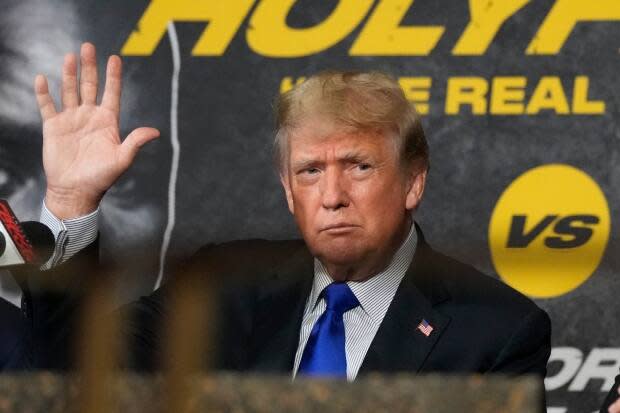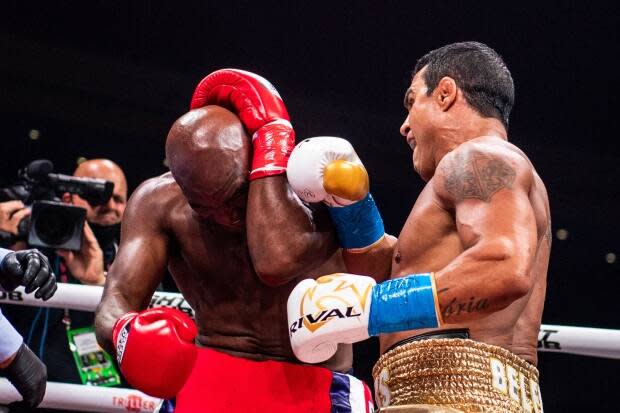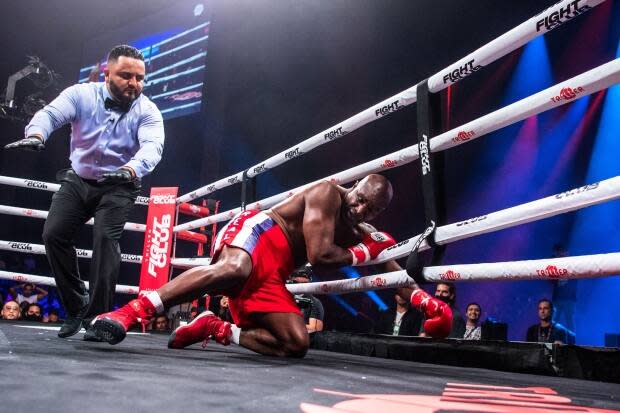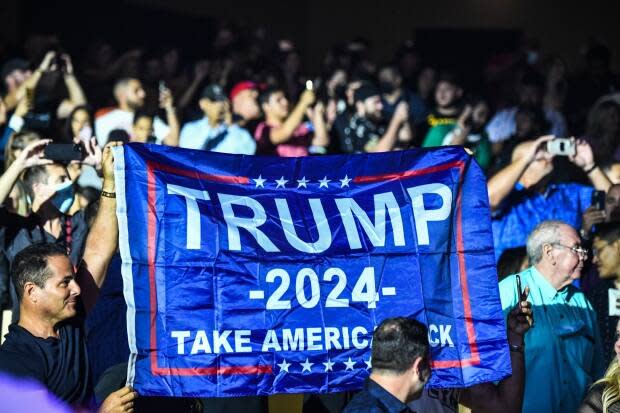Hiring Donald Trump as analyst shows novelty of celebrity fight cards wearing thin

This is a column by Morgan Campbell, who writes opinion for CBC Sports. For more information about CBC's Opinion section, please see the FAQ.
Back in June, Jim Lampley, the play-by-play voice of countless classic boxing matches, exposed the limits of his expertise when he argued that Floyd Mayweather's reign as boxing's top draw created the social and political environment that enabled Donald Trump to win the 2016 election.
That Lampley can't see the flaws in his argument signals that it's fair to question his intellectual firepower as a political scientist. But he was smart enough to quit his latest broadcast job, calling last Saturday's farce of a boxing match between Vitor Belfort and Evander Holyfield, after the fight's promoters hired Trump as an analyst, and before the two aging fighters could enter the ring.
Two days after the bout, in which the 44-year-old Belfort steamrolled the 58-year-old Holyfield in less than one round, the public relations firm hired to work the event announced that, like Lampley, it was finished working with Triller, the outfit that staged Saturday's card.
"EAG Sports Management is NO LONGER Working with Triller or Triller Fight Club EFFECTIVE IMMEDIATELY!" read a memo EAG president Denise White emailed to journalists Monday. "Feel free to print that!"
We don't know what prompted the sudden severing of ties, though it was possibly the false statements Triller officials scattered like seeds in the leadup to the fight. Triller told ESPN it was negotiating a commentary deal with former president Barack Obama; Obama's camp told the New York Times that idea was false.
It might have been the intentional fogginess around whether Saturday's main event was an exhibition, understandable between combatants with a combined age of 102, or an official fight, unconscionable given that Holyfield slurs his words and turns 59 next month.

Or maybe it was the putrid final product. Anderson Silva knocking out a punch-drunk Tito Ortiz in one round in the co-feature, and the ref halting the fight with the annoyed expression of someone summoned to clean up a mess he didn't make. Holyfield staggering around the ring, posing more danger to himself than he ever did to Belfort, who is a retired mixed martial artist with a history of both approved and illicit testosterone use.
It all unfolded while radical Trump supporters gathered in the live chat portion of the online broadcast to trade conspiracy theories about QAnon and Hunter Biden.
You could draft the slickest spin doctor on the planet, but you can't repackage any of those details as anything but what they were — a two-word synonym for disaster that rhymes with "spit snow."
But we did emerge from Saturday night with two clear positive outcomes. First, Holyfield left the ring on his feet — and not on a stretcher.

Second, the card offered a clean break between The Sweet Science and what we've been seeing lately. We witnessed the hard limits of novelty fights as a long-term business strategy. Most of the halfway famous people who want to box already have, and the big, faded, names still willing to endanger themselves are retired fighters, who can only look slow and sloppy compared to their past selves.
Triller has piped countless dollars into a business model that common sense and the science of aging say isn't sustainable, and Saturday night hinted at how ugly this could all become. From here, Triller can either pivot or risk getting some hobbyist or old-timer killed.
Easy choice for most folks but no guarantee for Triller, even though a mid-stream change of plans shouldn't be difficult. It's not a sports outfit, after all. It's a video sharing social media app, trailing TikTok by a wide margin in that category yet seeking ways to close the gap.
Triller cozied up to Trump when the then-president threatened to ban TikTok in the U.S. Before the company staged the Mike Tyson-Roy Jones exhibition last fall, its highest-profile users were right-wing American celebrities like Donald Trump Jr. It also partnered with Ice Cube's Big3 basketball league, and bought Verzuz, which gained fame staging nostalgia-infused battles between old-school hip-hop and R&B acts.
And then there's Triller Fight Club, whose previous instalments have included Tyson-Jones and YouTube star Jake Paul's win over retired UFC fighter Ben Askren. Saturday's main event was supposed to pit Oscar De La Hoya against Belfort in Los Angeles. But when De La Hoya was diagnosed with COVID-19, Holyfield stepped in to replace him. And when California officials, sensibly, refused to host the fight, the whole production moved to Florida.
Still, Triller didn't have much to sell. Holyfield retains some mainstream profile, but he's not as famous as Tyson, who attended Saturday's fight card, possibly sniffing for a bout with the winner. Belfort isn't famous outside the world of mixed martial arts, where he hasn't been relevant since the mid 2010s.
To gin up interest, Triller summoned Trump, a move that tells you everything about its imagined audience, and where the operation may as well be headed. The hope was that if sports fans wouldn't pay $50 to watch old guys fight, Trump fans would spend that much to listen to their favourite ex-president. It's a solid enough plan, given the variety of ways Trump separates his followers from their cash.

But if your strategy depends on squeezing money from Trump supporters, why do you even need boxing? Why not just stage a series of pay-per-view Trump speeches? Or start a subscription-only podcast? Or a 24/7 premium cable station, sort of like the aquarium channel, with audio of Trump reading The Art of the Deal over a montage of Trump portraits?
Any of those would sell better than more fights between brittle retirees, with nothing injured but good taste and the viewership's collective IQ.
The alternative is to try to revive a franchise that's as broken down as the fighters Triller hopes to feature. Holyfield turned pro the week after Ronald Reagan defeated Walter Mondale to win a second term as U.S. president, which is to say he's too old for any type of fist fight, competitive or exhibition.
Saturday's loss makes a Tyson rematch less likely, which leaves Triller with Belfort, whom most American sports fans couldn't identify without a name tag. You can build a celebrity boxing franchise around a non-boxer, but you still need a celebrity, and Belfort isn't one. The biggest name on the fight card was at ringside behind a microphone, calling the Brazilian Belfort a "great patriot" and griping about losing an election.
Attendance and gate revenue figures haven't yet been published, so we might never know how many — or how few — people watched Saturday's card. But if you, as a promoter, need Donald Trump's axe-grinding to sell your fights, maybe it's time to leave boxing for the people who love it.

 Yahoo Sports
Yahoo Sports 